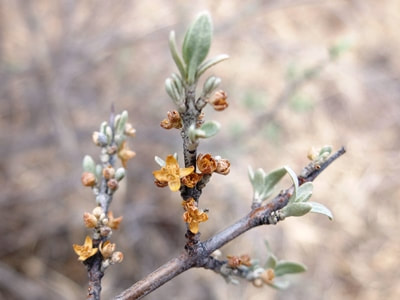|
The Bloom Blog Blooming this week in the environs of Abiquiú By Wildflowers of the Southern Rocky Mountains Found in moist areas, stream sides
Seen blooming in April by the Rio Chama Silver Buffaloberry is a native shrub growing to 15 feet tall in thickets. The silvery leaves, habitat and thorny stems cause it to be mistaken for Russian Olive, which is an invasive species. Several things differentiate them; leaves grow in opposite pairs while the leaves of the Russian Olive are alternate, flowers of the Russian Olive are much larger, brighter yellow, tubular and bloom later, the fruit is a red or gold berry while the Russian Olive produces “olives” covered with silvery scale, and the Russian Olive can grow to 35 feet tall. Male and female flowers are produced on separate plants. The tiny yellowish-brown flowers cluster on the stems. The photo is of male flowers. The fruits are an important source of food for birds and animals and are edible for humans, but tart. Native Americans consumed fruits both fresh and dried. Fruits were eaten as a laxative and for stomach troubles and fevers. Fruits were used occasionally in ceremonial feasts at female puberty rites and to make a red dye. Source. If you are trying to identify a different flower then you can check what other flowers bloom this month. If you cannot identify a flower from the website, send a photo and where you took it to [email protected]. Read online for tips.
0 Comments
Leave a Reply. |
AuthorI am Marilyn Phillips, a native of England, whose love of nature and the outdoors from childhood brought me by a circuitous route to Crested Butte, Colorado in 1993 and 16 years later to northern New Mexico. My exploration of the many trails in these areas, my interest in wildflowers and photography, and career in computer system design came together in this creation. If you have any corrections, comments or questions, please contact me by email. Archives
September 2025
Categoriescopyright © 2020
|



 RSS Feed
RSS Feed